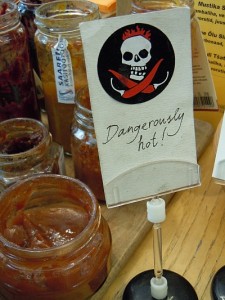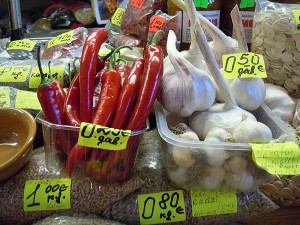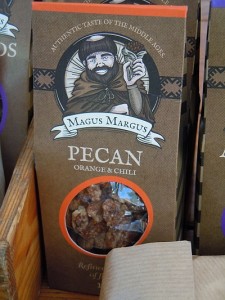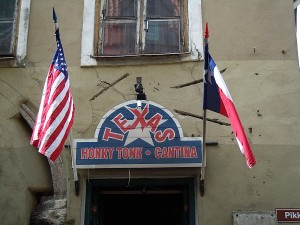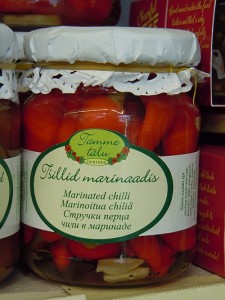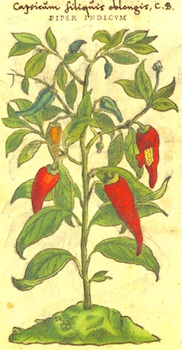Story and photos by Sharon Hudgins
Recipes:
The nine countries that border on the Baltic Sea aren’t known for spicy cooking. Fish, pork, potatoes, and beets, along with mushrooms, sour cream, and dill, have been the flavors of the Baltic for centuries. Horseradish was the only thing that spiked up a cuisine where bland foods were routine.
But over the past two decades an invasion of foreign restaurants has brought tongue-tingling tastes from warmer climates to this chilly part of northern Europe. On a recent trip around the Baltic coast—from Sweden to Finland, Russia, Estonia, Latvia, Lithuania, Poland, Germany, and Denmark—I was surprised to discover popular Mexican, Tex-Mex, barbecue, Korean, and Thai restaurants with menus that tout their spicy fare.
Americans traveling to this part of the world should remember that “hot peppers” on the menus are translated into English with the British spelling “chili,” not the American “chile.” So when you order something with “chili” in the Baltic, expect a dish that’s cooked with, or garnished with, hot peppers, not a spicy Texas meat stew.
At an open-air market on the waterfront in Helsinki, Finland, a food stand sells nachos with fried smelts and salsa. In another part of the city, the Cantina West restaurant advertises in English: “We combined FOOD with CHILI. Taste the right chili for every ingredient. Hand-made food with Finnish chili varieties. So hot you’ll drop.” And Helsinki’s Santa Fe restaurant , which offers Tex-Mex, Cajun, and BBQ, claims that it’s the “City readers choice 4 times” for “Best Food in Helsinki.” And you thought only the girls in Finland were hot!
Several food stalls at Copenhagen’s modern, upscale Torvehallerne indoor-outdoor food market sell dishes far removed from traditional Danish cuisine: chocolate muffins with chili, spicy Korean kimchee pancakes, and “spicy tuna mousse with kimchee, Tabasco, and chili. Ex-Noma chef Rosio Sanchez has recently opened a classic Mexican taco stand there, too. And home cooks can find a variety of fresh red and green hot peppers at the massive Central Market in Riga, Latvia, housed in five huge Zeppelin hangars, now part of the city’s UNESCO World Heritage Site.
Long thin peppers, red or green, are a visual symbol for “hot” in the Baltics. The logo of the popular Čili Pica restaurant chain, founded in Lithuania in 1997, features a long green pepper as the diacritical mark turning the red letter “C” in the company’s name into the sound of “ch” for “chili.” And the Finnish-owned Stockmann department store chain in the Baltics advertises its gourmet delicatessens with a huge sign showing a pretty woman wearing a strapless green evening dress and green stilettos, erotically embracing a long green pepper, taller than she is, while several other huge green peppers lurk like voyeurs on the sidelines.
After a month of eating my way around the Baltic coast, I awarded Tallinn, Estonia, the title of “hottest capital city.” Right off the boat, I found a little stand selling “Orange-Chili Pecans.” As I wandered through the Old Town, I came across restaurant ads with photos of pepper steak garnished with a long hot red pepper, spicy beef filet, and beef tips in spicy red pepper sauce. One restaurant menu listed “popular chili dumplings in creamy sauce, spicy ground beef crêpe in salsa sauce, ham and cheese crêpe with jalapeños, and chicken crêpe with vegetables and pineapple-jalapeño sauce.”
Tallinn’s Texas Cantina touts its spicy food with red stars on the menu indicating which dishes are “hot,” including Texas chili (yes, the meat stew), chipotle pork sirloin, enchiladas, and fajitas. And at the city’s largest bookstore, I even found a beautifully illustrated Tex-Mex cookbook published in Estonian.
Further proof of Tallinn’s taste for heat can be found in the well-stocked gourmet food store in the basement of the modern Viru Keskus shopping center, just outside the Old Town. Shoppers can load their baskets with jars of marinated red peppers, spicy salsa, pickled jalapeños, and red pepper jam, along with bottles of Louisiana and Tabasco hot sauces and plastic containers of freshly made Tex-Mex salad with salsa dressing.
If just looking at all that food makes you immediately hungry for heat, head for the colorfully decorated Amarillo Restaurant on the ground floor of the same shopping center, which serves “a fusion of hot Mexican food and the delicate flavors from the southern states of the U.S.” The mouthwatering menu lists hot wings, nachos, jalapeño poppers, tacos, burritos, tostadas, quesadillas, and fajitas. And their margaritas are reputedly the best in town.
So if you’re planning a trip to the Baltic region but wondering if you’ll have to survive on fish and potatoes the whole time, you’ll be in for a surprise. There’s plenty of heat to be found along the Baltic’s 5,000-mile coast. And if the touted spicy foods in restaurants and at street stands don’t rise to your preferred Scoville level, just pop into the supermarkets and load up on fresh hot peppers to spike any meal, even that boring fish and those boiled potatoes.
However, even traditional Baltic cuisines do have a few dishes that some local cooks turn into spicy fare. Following are recipes for three popular soups that you’ll find on the menus of restaurants throughout the eastern and southern Baltic region. If they’re not hot enough for your own taste, just add more hot paprika or cayenne.
Sharon Hudgins is a food and travel writer who has lived in 10 countries and visited more than 50 countries around the world. See more of her articles and recipes at sharonhudgins.com
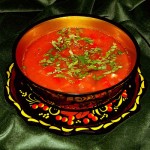
|
This soup of Russian/Ukrainian origin is also popular in the three Baltic States (Estonia, Latvia, Lithuania), Poland, and eastern Germany—an example of the influence of Russian foods on the cuisines of countries that were once under the domination of the Soviet Union. Solyanka's popularity is attributed to its versatility (using any kind of leftover meat or fish) and the combination of piquant flavors that make you crave a second bowl of it.
|
- 1/4 lb diced bacon
- 2 tbsp vegetable oil
- 2 each finely chopped onions
- 2 large cloves garlic minced
- 1 tbsp sweet (mild) paprika
- 1 tsp hot paprika (or more, to taste)
- 1/4 cup tomato paste
- 3/4 pound (12 ounces) cooked sausages (such as frankfurters, bockwurst, knackwurst), cut crosswise into 1/4-inch rounds Or a total of 1 pound of leftover cooked meats
- 1/4 pound (4 ounces) cooked ham, cut into thin strips (julienned)*
- 4 each small sour dill pickles, seeded and cut into thin strips, 2 inches long 2 medium pickles also works
- 7 cups beef stock
- 1 each bay leaf
- 1/2 tsp salt
- 1 tsp freshly ground black pepper
- 1/2 cup pitted whole black or green olives
- 1 tbsp pickled capers
- Heat the bacon and oil together in a large soup pot over medium heat to melt some of the bacon fat. Increase heat to medium-high, add onions, and sauté until golden. Reduce heat to low, stir in garlic and paprika, and cook, stirring constantly for 1 minute. Quickly stir in the tomato paste.
- Add the meats, pickles, stock, bay leaf, salt, and pepper. Bring the soup to a boil over high heat, then reduce the heat and simmer, partially covered, for 10 minutes. Add olives and capers and simmer 5 minutes more.
- Serve hot, each bowl garnished with 2 thin slices of lemon and a large dollop of sour cream.
|
|
|
|
|

|
Borscht is another Ukrainian soup whose popularity long ago spread to the eastern Baltic countries, especially Russia where it's now considered a national dish. Although borscht is usually not a hot-peppery soup, I've eaten some surprisingly spicy versions of it on my travels in Russia and Eastern Europe.
|
- 4 cups finely shredded green cabbage
- 3 each large beets, peeled and coarsely shredded
- 1 each large carrot, peeled, and coarsely shredded
- 4 cups water or meat stock (beef or chicken)
- 2 tsp salt (divided use)
- 1 lb beef (chuck roast), cut into 1/2-inch cubes
- 3 ea medium red boiling potatoes, peeled and cut into 1/2-inch cubes
- 1 tbsp tomato paste
- 1 each bay leaf
- 4 cups meat stock (beef or chicken)
- 4 tbsp sunflower oil (divided use)
- 1 each medium onion, diced
- 1 each medium green bell pepper, chopped
- 1 each medium red bell pepper, chopped
- 2 each medium tomatoes, coarsely chopped
- 2 tbsp red wine vinegar
- 1 tsp Tabasco sauce
- 1/2 tsp ground cayenne pepper
- Combine cabbage, beets, carrot, 4 cups of water (or stock), and 1 teaspoon salt in a large stock pot. Bring to a boil over high heat, then reduce the heat, cover, and simmer 30 minutes, stirring occasionally.
- While the vegetables are cooking, heat 2 tablespoons of oil in a large skillet and lightly brown the beef on all sides.
- After the vegetables have simmered for 30 minutes, add the beef and all pan juices from the skillet to the stock pot, along with the potatoes, tomato paste, bay leaf, and 4 cups of beef or chicken stock. Bring to a boil over high heat, then reduce the heat and simmer, covered, for 45 minutes. (Set a timer).
- Meanwhile, heat 2 tablespoons of oil in the skillet and sauté the onions and peppers until the onions start to soften. Stir in the garlic and sauté 2 minutes longer. Add to the simmering ingredients in the stock pot.
- Without wiping out the skillet, cook the tomatoes over medium-high heat for 3 minutes, then add them to the stock pot along with the vinegar, Tabasco sauce, cayenne pepper, and 1 teaspoon salt. Continue to simmer, covered, until your timer says the 45 minutes are finished.
- Serve hot, each bowl garnished with a large dollop of sour cream and a liberal sprinkling of chopped fresh dill.
|
|
|
|
|

|
Originally from Central Europe, goulash soup is so tasty that its popularity has spread northward to the eastern Baltic region, too. Today you'll often find it on menus in Germany, Poland, and the three Baltic States. As with other tangy soups in this region, Hungarian paprika is the spice that gives goulash soup its kick.
|
- 1/4 cup vegetable oil
- 2 each medium onions, finely chopped
- 1 lb boneless beef (chuck roast, arm roast), cut into 1/2-inch cubes
- 1/4 lb lean bacon, diced into 1/4-inch pieces
- 3 each medium tomatoes, coarsely chopped
- 2 each medium boiling potatoes, peeled and diced into 1/4-inch pieces
- 1 each green bell pepper, finely diced
- 1 each red bell pepper, finely diced
- 1 each leek (white part only), finely diced
- 6 large cloves garlic, finely chopped
- 2 tbsp tomato paste
- 3 tbsp sweet (mild) Hungarian paprika (or a mixture of mild and hot paprikas, to taste)
- 1 tbsp caraway seeds
- 2 tsp dried thyme
- 2 tsp dried marjoram
- 1 tsp salt
- 1 tsp freshly ground black pepper
- 3-4 cups water or beef stock
- Heat oil over medium-high heat in a 5-quart stockpot, and sauté the onions until they begin to turn brown. Add beef and bacon to the pot. Cook, stirring constantly, until beef is browned on all sides. Add tomatoes, potatoes, bell peppers, leek, and garlic. Stir well to combine, then add tomato paste, paprika, caraway seeds, thyme, marjoram, salt, black pepper, and water or stock. Bring the mixture a boil, reduce the heat, and simmer the soup, uncovered, for 1 hour, stirring occasionally. Taste and add more salt if desired.
|
|
|
|
|






